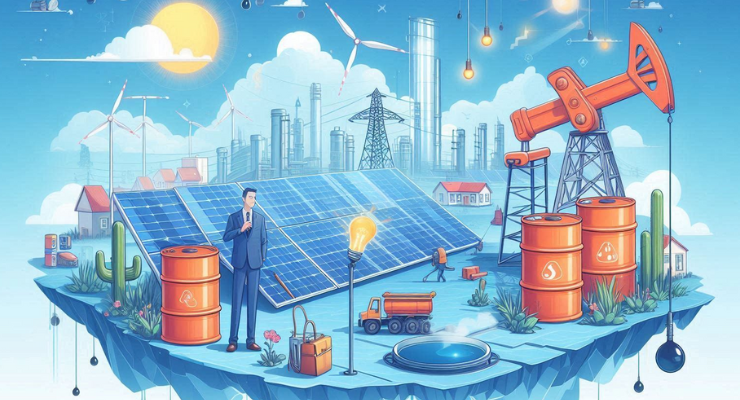Fast read
Renewable energy comes from natural sources that constantly replenish themselves, such as the sun, wind, water, and biomass. Solar panels, wind turbines, hydroelectric dams, and geothermal plants are common examples of renewable energy technology.
Nonrenewable energy sources such as coal, oil, and natural gas are limited and harm the environment, causing climate change. Transitioning to renewable energy is essential for reducing pollution, combating climate change, and ensuring a sustainable energy future.
What Is The Difference Between Renewable and Nonrenewable Energy Sources?
In today’s world, understanding the difference between renewable and nonrenewable energy sources is more important than ever. Both types of renewable energy sources have their own advantages and disadvantages, and both play a crucial role in powering the planet and our daily lives. By understanding the distinctions between these two types of resources, we can make more informed decisions about how we use energy and how we protect our environment for future generations.
Renewable vs Nonrenewable Energy
The key difference between renewable and nonrenewable energy sources lies in their availability and sustainability. Renewable energy comes from sources that can be replaced, while nonrenewable energy comes from resources that will run out. This fundamental difference impacts their environmental footprint, cost, and overall sustainability.
Renewable Energy
Renewable energy comes from natural sources that constantly replenish themselves. These sources offer a more sustainable and environmentally friendly option because they do not emit pollutants and greenhouse gases that harm the planet.
Solar Energy
Solar energy is harnessed from the sun’s rays using photovoltaic cells or solar panels.
Wind Energy
Wind energy is captured through wind turbines that convert kinetic energy from the wind into electricity.
Biomass Energy
Biomass energy comes from organic materials like plant and animal waste. This type of energy can be used for heating, electricity generation, and as a fuel for transportation.
Hydroelectric Energy
Hydroelectric energy is generated by using the flow of water in rivers, streams, and dams to produce electricity. It’s one of the oldest and most reliable forms of renewable energy.
Geothermal Energy
Geothermal energy harnesses heat from beneath the Earth’s surface.
Nonrenewable Energy
Nonrenewable energy sources are derived from finite resources that cannot be replenished in a short period of time. These sources include fossil fuels and nuclear energy.
Coal
Coal is a fossil fuel that is mined from the Earth and burned to produce electricity. It is a significant source of energy but also a major contributor to air pollution and greenhouse gas emissions.
Oil
Oil is extracted from underground reservoirs and used to produce fuels like gasoline, diesel, and jet fuel. It is also a key raw material in the petrochemical industry.
Natural Gas
Natural gas is a fossil fuel that is used for heating, electricity generation, and as a fuel for vehicles. It produces fewer emissions than coal and oil but is still a significant source of greenhouse gases.
Nuclear Energy
While it generates a large amount of energy with low greenhouse gas emissions, it also produces radioactive waste that must be carefully managed.

Advantages of Renewable Energy
Renewable energy offers numerous benefits, from combating climate change to creating jobs and boosting the economy. Here are three key advantages:
1. Combatting Climate Change
Renewable energy sources do not emit greenhouse gases, which are the primary cause of climate change. Renewable energy reduces CO2 and other harmful pollutants. This helps lessen the effects of climate change, such as rising sea levels and extreme weather events.
2. Inexhaustible Sources
Renewable energy sources are inexhaustible because they are derived from natural processes that are constantly renewed, such as sunlight, wind, and the water cycle. This makes them a reliable and sustainable option for meeting our long-term energy needs.
3. Economic Benefits and Job Creation
The renewable energy industry is rapidly growing, creating millions of jobs worldwide. Renewable technologies are getting cheaper, making them a better option than nonrenewable sources. This can save money for businesses and consumers.
Disadvantages of Renewable Energy
1. Intermittent Availability
Renewable energy sources like solar and wind are not always available 24/7, as they depend on weather conditions. This intermittency can pose challenges for maintaining a consistent energy supply.
2. Space Requirements
Renewable energy projects need a lot of space, which may not work in crowded areas or places with difficult terrain. For example, large solar farms and wind farms need ample land to operate efficiently.
3. High Initial Costs
The initial costs of installing renewable energy systems can be high. However, as technology advances and becomes more widespread, these costs are expected to continue decreasing.
Advantages of Nonrenewable Energy
Nonrenewable energy sources currently supply the majority of the world’s energy needs and have certain advantages:
1. Cost-Effectiveness
Nonrenewable energy sources are currently more cost-effective than many renewable options, largely due to existing infrastructure and subsidies. This makes them a more affordable choice for many consumers and industries.
2. High Energy Density
Fossil fuels have a high energy density, meaning they contain a large amount of energy per unit of weight. This allows them to produce more energy than most renewable sources, making them highly efficient.
3. Reliable Supply
Nonrenewable energy sources can provide a reliable and continuous supply of energy, regardless of weather conditions. This reliability is crucial for meeting the energy demands of modern society.
Disadvantages of Nonrenewable Energy
Nonrenewable energy sources have significant drawbacks that impact both the environment and human health:
1. Environmental Degradation
The extraction and use of nonrenewable energy sources contribute to environmental degradation, including air and water pollution, habitat destruction, and greenhouse gas emissions. These activities exacerbate the impacts of climate change and have long-term ecological impacts.
2. Health Risks
The pollutants released by burning fossil fuels can cause serious health problems, including respiratory illnesses, cardiovascular diseases, and cancer. These health risks affect millions of people worldwide, particularly in areas with high levels of air pollution.
3. Finite Resources
As resources become scarce, the cost of extracting them increases. This decrease in profitability is due to the rising extraction costs.



